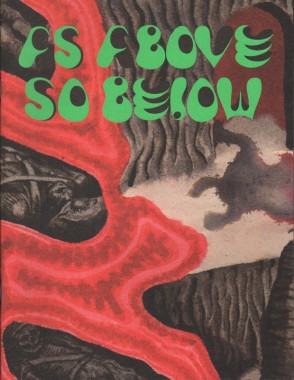
Will Sweeney, As Above So Below
Softcover, 16 pp., offset 5/5, 195 x 255 mm
Edition of 1000
ISBN 978-3-905714-78-4
Published by Nieves
$14.00 · out of stock –>
As Above So Below is a visual narrative based on a series of randomly selected photographs from my collection of National Geographic Magazine, dating between 1940 and the present day. The idea was to take visual motifs from a version of the real world and push them into the realm of the subconscious, a kind of dream generator. Dreams are made up of fragments of experiences, elements of stories which when laid side by side, often become striking or fantastical. Using a random number generating website I created a series of numbers. Each series became a month, year and page number, which were then cross referenced with a corresponding magazine. The first image that came up was from an article describing an archeological dig at a Corsican pagan tomb, the second a photograph of temple street market in Hong Kong, other references came up with pages of text and I would fix upon a phrase or name which conjured up an interesting image — such as an unfinished castle, upon an island or an animal shedding it’s skin. The theme of crossing dimensions and of an event happening simultaneously across the world emerged. The title comes from medieval hermetic philosophy, and relates to the alchemical relationship between microcosm (the body) and macrocosm (the universe).
Art, Distribution, National Geographic, Nieves, Will Sweeney
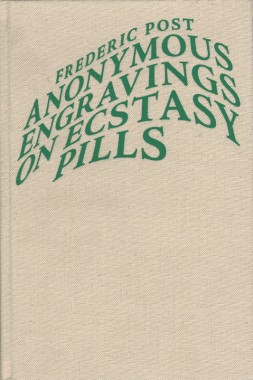
Frédéric Post, Anonymous Engravings on Ecstasy Pills
Hardcover, 544 pp., offset 1/1, 154 x 232 mm
Edition of 500
ISBN 978-2-940409-02-0
Published by Boabooks
$68.00 ·
The patterns used in
Anonymous Engravings on Ecstasy Pills were designed by unknown people who abandoned them. In this book of drawings, Frédéric Post offers a piece of research worthy of a modern-times archaeologist. He collected and re-created these figures, conferring thus value to an underground iconography of over 500 signs.
The classification of the drawings into three groups (figures, typography, symbols) was carried out with Izet Sheshivari. The collection shows elements of a visual folklore that hints at popular figures. The book implicitly describes our societies’ ambiguities: “Nowadays, with drug use, we want to experiment this unconstrained pleasure, disrupt the humdrum routine, make love longer; we want to party even though we are tired (…). At the end of the day, this is in line with the whole idea of work, profitability and performance”. Is ecstasy therefore an excessive metaphor of the market economy?
Art, Boabooks, Culture, Distribution, Frédéric Post, Izet Sheshivari
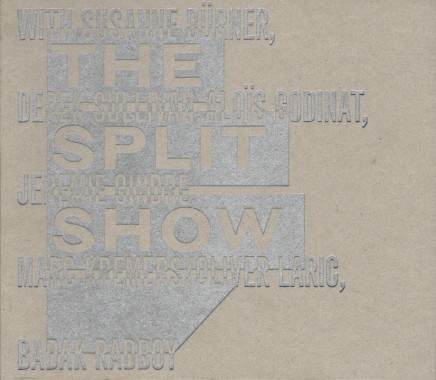
The Split Show
Hardcover, 144 pp., offset 4/1, 230 x 200 mm
Edition of 450
ISBN 978-2-940409-18-1
Published by Boabooks
$38.00 ·
A wall-less group show
Publishing a book is in many ways similar to curating a show. The Split Show is the outcome in this idea — a group artists book. The basic idea was to ask artists to create a recto/verso 720 x 1020 mm poster. Once folded, this format becomes a 24-page 230 x 200 mm folio.
Aloïs Godinat, Art, Babak Radboy, Boabooks, Derek Sullivan, Distribution, Izet Sheshivari, Jérémie Gindre, Marc Kremers, Oliver Laric, Susanne Bürner
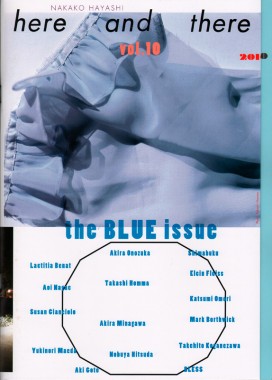
Nakako Hayashi, Here and There 10
Softcover, 64 pp., offset 4/duotone, 210 x 297 mm
Edition of 1000
ISBN 978-3-905714-88-3
Published by Nieves
$20.00 ·
“A year ago, I visited Aichi prefecture in the end of summer. It was to reflect on the work of Nobuya Hitsuda, as well as to see the exhibition “In the Little Playground: Hitsuda Nobuya and his surrounding students” that reflects on the time, in his 40 years of teaching experience, he spent with his students, such as Yoshitomo Nara, Hiroshi Sugito, Kyoko Murase, Mika Kato and many more.
Although having visited on an assignment, I was overwhelmed with emotion. Even for people who are actively recognized, there are still moments, numerous times in your life, where one needs to spend those blue hours alone. The process, to be alone, to suffer with unsettled emotion, is necessary to move forward.
Around the same time, I was asked by chance to write an essay, and decided to write on raising children. Raising children is also about continuous time that cannot be controlled. In the end of that summer, those were the two things that were on my mind, so I decided to put together an issue for Here and There, focusing on the blue hour that can make our lives colorful, as well as the color blue itself.
I looked up at the blue sky. Blue is a color that represents the beauty of nature, but at the same time, it exists in many things manmade. Blue can be found in clothing you wear against your skin, somewhere near you, and far away. The aim is to seek for a blue in personal emotions and in the growing process of people and to find it scattered in the world. This, hoping that it will be an attempt to sprout something in people’s hearts.”
—Nakako Hayashi
Aki Goto, Akira Minagawa, Akira Onozuka, Aoi Nagae, Art, Bless, Distribution, Elein Fleiss, Fashion, Here and There, Katsumi Omori, Kazunari Hattori, Lactitia Benat, Mark Borthwick, Nakako Hayashi, Nieves, Nobuya Hitsuda, Susan Cian, Takashi Homma, Takehito Koganezawa, Yukinori Maeda
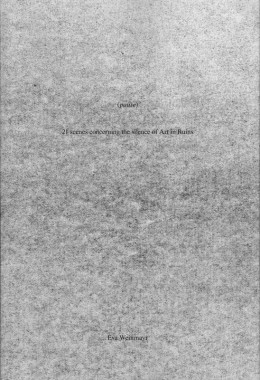
Eva Weinmayr, (pause) 21 scenes concerning the silence of Art in Ruins
Softcover, 72 pp., offset 1/1, 210 x 297 mm
Edition of 500
ISBN 978-0-9562605-4-3
Published by Occasional Papers
$16.00 ·
Why did Art in Ruins, a once prominent art collective, suddenly fall off the art world map? Did they run out of ideas, move on to other territories or simply withdraw in disgust? During brief lulls in their frenetic peregrinations around the glittering international art circuit, a loose group of artists, curators, critics and other art professionals discuss the mysterious disappearance of Art in Ruins, maintaining a sober tone of inquiry even as they encounter herds of bison, anomalous Richard Serra walls and security personnel steeped in art theory. Using actual dialogue from interviews with art professionals who knew Art in Ruins, Eva Weinmayr constructs a hypothetical play as an anti-documentary or anti-biography.
Art, Criticism, Distribution, Eva Weinmayr, Fiction, Occasional Papers, Richard Serra, Sara De Bondt, Theory, Zacheta National Gallery of Art
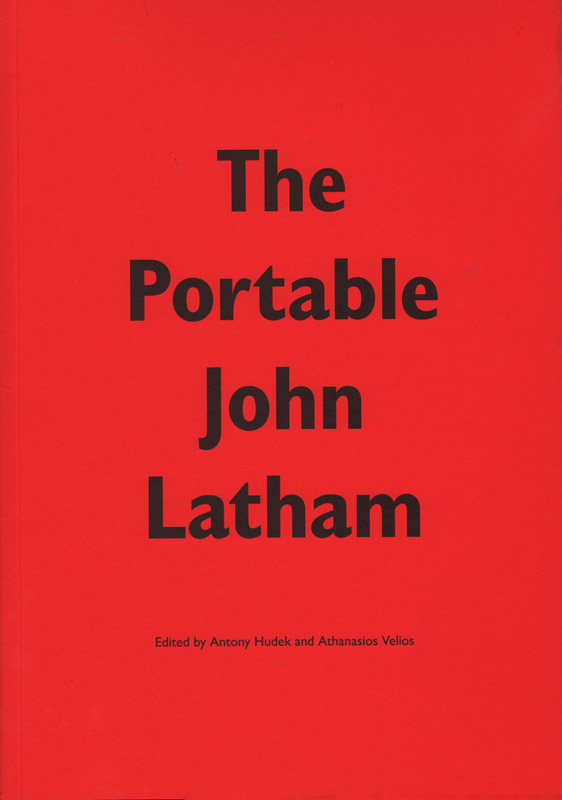
Antony Hudek and Athanasios Velios, The Portable John Latham
Softcover, 112 pp., offset 2/1, 170 x 250 mm
Edition of 1000
ISBN 978-0-9562605-5-0
Published by Occasional Papers
$22.00 ·
This book features a selection of documents from the personal archive of the late British artist John Latham (more information
here), presently maintained in his last home and studio in Peckham, South London. Through reproductions of letters, invitation cards, exhibition reviews, performance scripts and images, the publication retraces Latham’s pioneering practice over six decades, from the late 1940s to his death in 2006. Published on the occasion of
John Latham: Anarchive in association with Whitechapel Gallery, the book also includes an interview by Charles Harrison from 1968 and a glossary section.
Edited and introduced by Antony Hudek and Athanasios Velios.
In the painting and sculpture for which he is best known, Latham’s primary materials included glass, books, canvas and the spray gun. Developing alongside this concise visual language, from the mid-1950s onwards, was a cosmological theory, formulated through his art-making discoveries, that considered time and event to be more primary than the established means of understanding, based on space and matter. Termed Time-Base Theory (sometimes Flat Time Theory or Event Theory) it offers an ordering and unification of all events in the universe, including human actions, and allows an understanding of the special status of the artist in society.
Latham looked at the way in which human knowledge has become fragmented over time; split by divergent religions, ideologies and world-views. He identified the way in which the fields of science and art, despite emerging from a common root, have become separate and operate in isolation of one another: even within a field such as physics, there exist a large number of schisms and specialisations that further fragment our knowledge and understanding of the universe. John believed that this endless division would eventually lead to a kind of entropy and from that state, to a disintegration of society.
Antony Hudek, Art, Athanasios Velios, Charles Harrison, Criticism, Culture, Distribution, John Latham, Occasional Papers, Sara De Bondt, Science, Theory, Typography
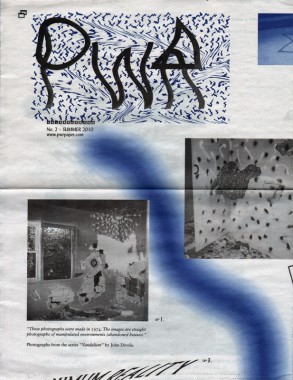
Hanna Terese Nilsson and Rasmus Svensson, PWR 2
Newspaper/poster, 16 pp., web offset 2/2, 570 x 760 mm
Edition of 1000
Published by PWR Paper
$6.00 · free* ·
*free copy with each order
Both the future and the past are mysterious places filled with hidden delights and lurking dangers. This is a poster-magazine about traveling in time as well as in (cyber)space. The third manifestation of PWR will be revealed shortly.
Gothenburg, Sweden, Earth, Internet.
Alexander Palmestål, Amanda Svensson, Andreas Banderas, Arran Ridley, Art, Artie Vierkant, Ben Jones, Brenna Murphy, Daniel Swan, Distribution, Elina Minn, Graphics, Hanna Terese Nilsson, Ida Lehtonen, Ignace Wouters, John Divola, Lisa Öberg, Louie Schumacher, Matt lock, Mikael Enqvist, Natalie Rognsøy, Photography, Poster Company, PWR Paper, Rasmus Svensson
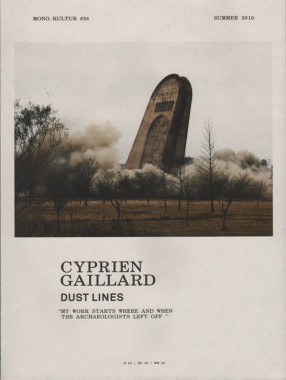
Mono.Kultur 24, Cyprien Gaillard
Softcover, 48 pp., offset 4/4, 150 x 200 mm
Edition of 5000
ISSN 1861-7085
Published by Mono.Kultur
$9.00 ·
It was late January when Cyprien Gaillard arrived, the time of year when the city is cold and grey. Yet the weather could not dampen his enthusiasm for urban exploration. He could hardly wait to wrap up the installation of his exhibition at the Wexner Center for the Arts to see Columbus, the state capital of Ohio. In line with his artistic interests in the contradictions of our contemporary landscapes, his list of must-sees included structures and places that others would rather ignore, and sites where contemporary claims to history have given rise to surprising visual manifestations.
We had started the day with a drive-by tour of fraternity and sorority houses — a staple of any North American university campus. Equipped with a Polaroid camera, Cyprien Gaillard began to survey the facades: Clustered together in an area of old, tree-lined streets, the architecture borrowed liberally from various periods and styles: Lily-white, Greco-Roman temple fronts alternated with Colonial-style brick facades, Tudor half-timber and 1960s austerity. The buildings laid bare the friction between the grandiloquent desires of the past and the rather more mundane present. Just as we were about to leave, a handful of student revellers emerged from one of the fraternities with beer cans in hand and posed for a photograph in the brisk morning air.
Anna Saulwick, Architecture, Art, Caroline Heuer, Catharina Manchanda, Cyprien Gaillard, Distribution, Elodie Evers, Eva M Goncalves, Florian Rehn, Joel Alas, Kai von Rabenau, Magdalena Magiera, Mario Lombardo, Matthias Sohr, Mono.Kultur, Renko Heuer, Sam Cate-Gumpert, Sarah Ryan, Tina Wessel, Urs Bellermann, Ute Kuhn
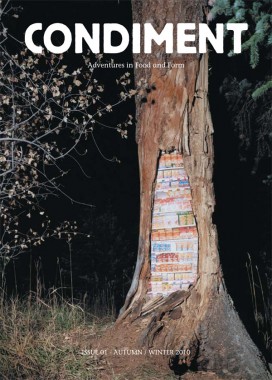
Condiment 1 — Adventures in Food and Form
Softcover, 72 pp., offset 4/4, 165 x 230 mm
Edition of 1000
ISSN 1837–8226
Published by Condiment
$18.00 ·
Condiment — Adventures in Food and Form is a publication and project-base exploring the relationship between food and creativity and food and community.
For the most part, food is nature at its most familiar. While views on its production and presentation become ever more complex and conflicted, it is nevertheless us that set the parameters.
As its masters we think: food is here to serve us. But quite possibly: we are here to serve food. Reversing the roles and giving up control is an eye-opening exercise. After all it is we who are dependent on food, and not food that is dependent on us.
One key attribute to the good servant is enthusiasm and enthusiasm is most often found in the amateur. The true amateur, of which E.C. Large was proudly an advocate, is defined as “one who loves”.
Beyond our own lack of expertise, although that is true too, it is this simple sentiment that has informed Condiment — Adventures in Food and Form. Equal parts wonder and worship, each page of this publication is not as much about what we do know as what we don’t.
Amanda Maxwell, Anders Jander, Art, Chris Barton, Christopher LG Hill, Condiment, Darren Sylvester, Distribution, E.C. Large, Ellen Birrell, ffiXXed, Food, Jessica Brent, Martino Gamper, Melanie Bonajo, Per Englund, Postalco, Ready For The House, Shauna T., Taiyo Onorato and Nico Krebs, Yumiko Utsu
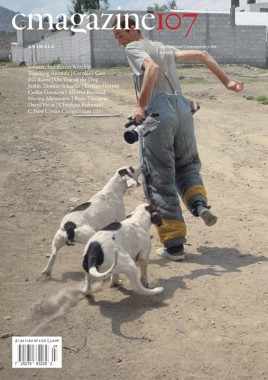
C Magazine 107, Animals
Softcover, 64 pp., offset 4/1, 210 x 295 mm
Edition of 2000
ISSN 1480-5472
Published by C Magazine
$7.50 ·
Issue 107 includes feature essays by Carla Benzan, on Carolee Schneemann’s cats; Karen Houle, on ethics and animal kinship; Jon Davies, on Mike White’s film, Year of the Dog; and Helena Reckitt, writing about human/non-human animal relationships; book and exhibition reviews from Calgary, the Alberta Biennial in Edmonton, Dublin, Halifax, Montreal, New York, Paris, Peterborough, Toronto, the winning entry for the 2010 New Critics Competition from Minneapolis; and an artist project by Bill Burns, with an essay by Gentiane Bélanger.
Adrian Blackwell, Aileen Burns, Alex Snukal, Amish Morrell, Art, Bill Burns, C Magazine, Carla Benzan, Christian Boltanski, Criticism, Dan Adler, Daryl Vocat, David Hoffos, Distribution, Gentiane Bélanger, Helena Reckitt, James D. Campbell, Johan Lundh, Jon Davies, Jovana Jankovic, Karen Houle, Kristan Horton, Leah Modigliani, Leah Turner, Marina Abramović, Marion Wagschal, Maxine Proctor, Nadja Sayej, Quyen Hoang, Ryan Trecartin, Sally Frater, Sarah Parsons, Stephen Kelly, Theory, Zoë Chan
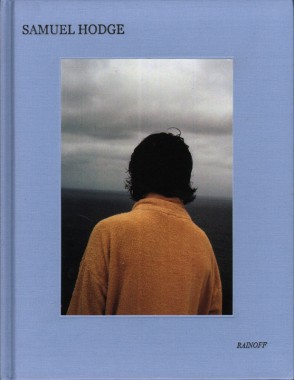
Samuel Hodge, Pretty Telling I Suppose
Hardcover, 72 pp., offset 4/4, 203 x 266 mm
Edition of 500
ISBN 978-0-9806516-0-7
Published by Rainoff Books
$45.00 ·
Foreword by Gert Jonkers.
Art, Culture, Distribution, Gert Jonkers, Photography, Rainoff Books, Samuel Hodge
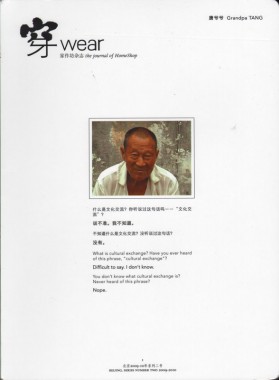
Elaine W. Ho, Wear 2010 (Cultural Exchange)
Hardcover, 80 pp. + 28 pp. insert, offset 4/4, 185 x 250 x 28 mm
Edition of 500
ISSN 2078-8691
Published by HomeShop
$25.00 ·
This issue and the second season of HomeShop are marked by a more cynical bent, whereby the pointedness of quotation marks, as in “cultural exchange”, invite investigation into the deeper multiplicities and ambivalence hidden within this overwrought term. Continuing its documentation of daily life in the hutong, Wear number two intertwines HomeShop’s series of exercises in cultural exchange with commentary, imagery and special projects on the topic by contributors such as Carol Yinghua Lu, RAQS Media Collective, Meiya Lin and Michael Eddy. A special 28-page insert has also been created especially for the journal by artist Reinaart Vanhoe.
Wear is the independently published journal of HomeShop, an artists’ initiative located in one of the hutong alleyways in the centre of Beijing. Aiming to be an annual project, WEAR combines an artist book, theoretical reader and social research in printed form. The journal documents the public activities, discussions and interventions organised at HomeShop, also serving as a broader platform from which to gather contributions from artists, writers and the folks in the neighbourhood for a local dialogue and everyday reflection upon the contradictions and dynamism of a fast-changing China.
Anouchka van Driel, Art, Barbara Fang, Beatrice Ferrari, Carol Yinghua Lu, Claude Tao, Culture, Distribution, Elaine Ho, Fashion, Gao Bei, HomeShop, Mai Dian, Meiya Lin, Michael Eddy, Qu Yizhen, Reinaart Vanhoe, Wear, Xia Jian, Yan Teng
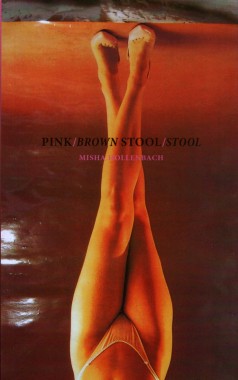
Misha Hollenbach, Pink/Brown Stool/Stool
Softcover, 64 pp., offset 4/4, 4.5 x 7 inches
Edition of 250
ISBN 978-0-9825936-3-9
Published by Seems
$24.00 ·
Born last century. Based in Melbourne, Australia. Misha Hollenbach lives and works in many languages, times and places. Hollenbach is one half of the brand Perks and Mini (P.A.M.) a multi media excursion encompassing art, design, fashion, and publishing. He is also part of The Changes, music and art collective.
Hollenbach is influenced by energy, as his work moves through various mediums including sculpture and painting, printed media and collage. Rather than shy away from objects deemed useless, or unwanted, he embraces their meaningless meanings to create an unfamiliar language containing familiar objects. By employing found objects and pairing them with wit and humor, he continues the narrative of the Dada and Pop artists.
In a lineage that extends through Jim Shaw, Andy Warhol and Marcel Duchamp, the rallying around the already readymade repositions things for freer symbolic enterprises. In the re-presentation of shit, Misha touches upon the etymological origins of faeces, which derives from faex, the Latin for dregs. He is using the dregs, things humans have casted away; shit becomes a metaphor for the unwanted.
By putting these outcasts back together with ready mix, the images of the objects do not return to us as they normally should; they lose their original function. With this method, he is breaking our own need to put the image back together in a fixed or familiar way. He strips back the structure of meaning — and this brings about a danger: the readymades return as phantasms and representations of abstract ideas. A Hush Puppy becomes a Push Poopy. Doodoo becomes Dada.
—Timothy Moore
Andy Warhol, Art, Culture, Distribution, Jim Shaw, Marcel Duchamp, Misha Hollenbach, Seems, Timothy Moore












